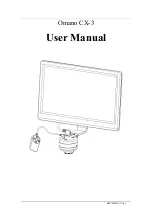
8.7.2.1
Free-running triggering
When you use
Free-running
as triggering concept, the camera will acquire images or
profiles with a regular time interval. The time interval is controlled by the
Timed profile
rate (Hz)
parameter.
When the acquisition of profiles is free-running, the distance between two profiles
varies if the speed of the object is not constant. This may distort the image. To avoid
distortion, you can use an encoder and embed encoder data for each profile. This
information makes it possible to calculate a correct image.
NOTE
The exposure time and the profile rate are inter-dependent. The maximum exposure
time cannot be longer than the time between two profiles, minus about three microsec‐
onds that are needed for readout and reset.
When you use the
Free-running
mode input, profiles are acquired at fixed time intervals
independent of the object motion. Note that the profile meta data contains valid
encoder position information also in this mode if an encoder is connected and active.
The
Encoder mode
parameter is not used.
8.7.2.1.1
Setting free-running triggering
Tabs:
2D Image
,
3D Image
Open the
Profile triggering
category in the parameter settings section.
1.
Select the
Free-running
radio button.
2.
Set the rate at which the profiles in an image are captured in
Timed profile rate (Hz)
parameter.
For 2D image triggering, the encoder input is always used as trigger source.
8.7.2.2
Encoder triggering
When you use an encoder for triggering, the camera counts the number of pulses
received on the encoder inputs using an internal counter. When the specified number
of pulses has been received, a profile or a 2D image is triggered and the camera resets
the triggering condition counter.
Four-phase (dual-channel) encoder
The default definition of a pulse is a full four-phase cycle on the encoder inputs. This
gives a pulse counter that is robust to jitter and noise on the inputs. It is also possible
to use a high-resolution encoder pulse counting mode, where each flank on an encoder
input is counted. In this mode, a 4-times higher resolution is achieved, but in Direction
and Motion modes (see below) jitter on the input may lead to unwanted triggering.
A four-phase encoder can handle movements in both directions (forward and back‐
ward). The camera can be configured to react to the pulses in different ways, resulting
in different ways to trigger profiles. The different profile triggering modes are illustrated
below.
Encoder
mode
Description
PositionUp
or
PositionDown
The encoder triggers a profile for each object position.
If the object has moved backward, no profiles are triggered until
the object has moved (at least) an equal distance forward.
PositionUp
: "Forward" is defined as the positive direction.
PositionDown
: "Forward" is defined as the negative direction.
CONFIGURATION
8
8026049//2021-04 | SICK
O P E R A T I N G I N S T R U C T I O N S | Ruler3000
57
Subject to change without notice
















































